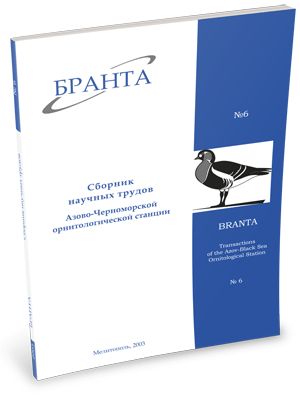
Transactions
of the Azov-Black Sea Ornithological Station



Great Bustard Albino: new data about species breeding biology
Andryushchenko Yu.A., Stadnichenko I.S.
The animal albinism is a complete or part absence of the tunic colour. It is a very interesting biologic phenomenon. There is a hypothesis that the albinos of the species especially that with the protective colouring are subjected to more frequent elimination. The most negative results of such elimination are for rare and vanishing species, where each individual is of great importance for the population in whole, moreover if the population range is located in areas with high people density. Over the period 2002-2003 we investigated this phenomenon on the example of Great Bustard, the species breeding in South Ukraine. This species is influenced by powerful human pressure.
At the village of Bagerovo, Kerchensky Peninsula (the Crimea) an albino was registered in the flock of Great Bustards 10 October 2002. Dirty white colour dominated in its plumage. Those parts, which are normally black, were light-greyish-white: especially they were tips of pen-feathers and tail feathers, and also but in much less degree large strips on back coverts, neck backside and crown. Bars on the wings were visible only during the flight while other more dark spots could be seen only while the bird was standing on the ground. Spots on the tail feathers were observed only when the tail was turned up (fig. 1).
Observations of the albino, "marked" with white colour of the plumage gave new interesting data about Great Bustards in the breeding period. It is one more argument for using the colour marking to study this species biology in details.
The albino was met again in the same region 16 April 2003. It was a female hatching its clutch of two eggs. The light coloured female was not seen before its flight because of high grass around the nest: h=50-70 cm, vegetation cover density - 30-50%. It allows suggesting that normally coloured females of Bustards can safely feed at the nest, being in sight of an observer but still unseen. Careful behaviour characteristic for the Bustard females considerably compensated failures in colouring of the albino. The bird was successful not only to lay fertilized eggs but incubate them for 16-20 days.
To conserve the eggs they were substituted by wood models with specific form and colour.
It was planned to change them again just before hatching of the nestlings. However on next checking of the nest we discovered that the models had been disappeared. 11 and 12 June the nestlings hatched from the eggs in the artificial hatcher. The nestlings' fluff was typically coloured without any traces of the albinism.
From early July the albino stayed within 3 km from its nest in the group of other females (from 1 to 7 individuals). As most other Bustards this group, periodically changing in its number, moved to the stubble after the harvest time. The females stayed separately from males not uniting in the flocks. The fact that the strongly marked albino was for the first time recorded only in autumn 2002 and in spring 2003 it already began breeding allows suggesting that the Bustard females are able to breed on the second year of their life.
Using the chance the authors express their sincere gratitude to H.Litzbarski and H.Watzke from German Bustard Society (Foderverein “Grosstrappenschutz") for assisting works on study the Bustard breeding in South Ukraine and to O.Dudkin (Ukrainian Society for Bird Conservation) who gave a special camera to take pictures of wild birds.
Read the paper in a PDF file